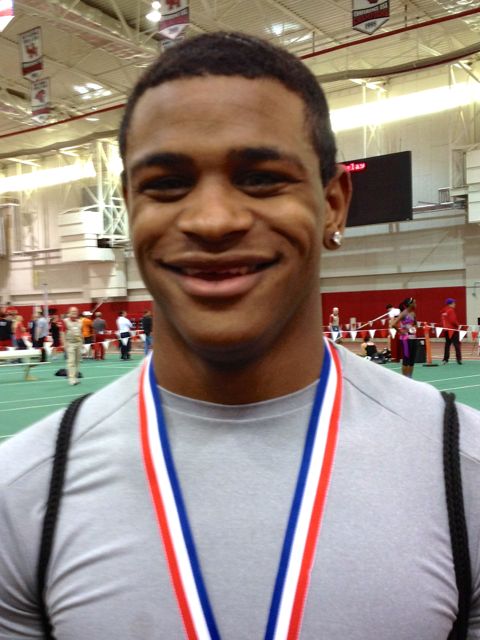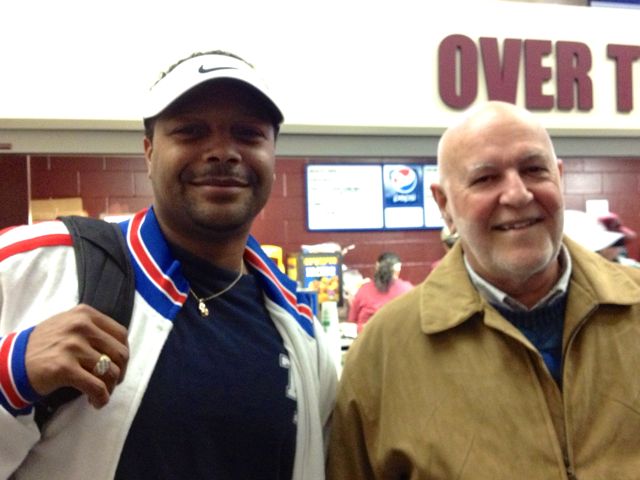NBNi 2013 Athlete Profile - Andre Jefferson
 Just wait until Texan Andre Jefferson's aching left ankle is at 100 percent strength.
Just wait until Texan Andre Jefferson's aching left ankle is at 100 percent strength.
Just wait until he gets the chance to speed down a world-class indoor indoor long jump runway.
Just wait to the moment he gets to compete against his top contemporaries on the nation's biggest of all scholastic stages. In short, just wait until 12 noon on Saturday, March 9th, when the John Tyler High School senior gets his long-awaited chance to jump his heart out at the New Balance Indoor National Championships at New York's Armory Track Center.
"I've never been to New York City," Jefferson said in a telephone interview. "I just know they have a lot of big lights, a lot of traffic, and a lot of people. And, of course, a lot of great things going on at the Armory."
Amid all that congestion, however, there's always room for individual talent to sparkle through, and it would be a huge shock if Jefferson didn't do exactly that.
Just as his father did, actually.
But more about that later.
A quick look at the charts shows that Andre Jefferson owns the five best performances in America this winter. Tops is his 24-11 victory at the Carl Lewis Invitational Meet at Houston on Feb. 2. And right behind that one are these other triumphal Jefferson leaps: 24-8 1/2, 24-7 3/4, 24-4 1/2 and 24-2 1/4.

Just one other American long leaper had gone past 24 feet as the indoor campaign turned the corner from January into February. That was Desmond Mobley (shown right) of Rochester, N.Y. at 24-1.
"I hope to see a lot of those guys at the Armory," said Jefferson. "Should be a great experience."
The Jefferson family has already had years of great track and field experiences.
His big brother, Tyris Jefferson, was the 2012 Texas 5A state champion in the long jump and is now a redshirt freshman at Kansas State University.
It's their dad's family long jump record they both hope to challenge in the years ahead.
Competing for the University of Arkansas, Tyrus Jefferson spanned a career-best 26- 11 1/4 in 1986.
He continued at the top of his game for two more years and was one of the best in the world, too. Yet he never did achieve the goals he'd always expected.
It was all a matter of timing.
Those late 1980s are still considered the golden era of long jumping - with the likes of Carl Lewis (the four-time Olympic champion), Mike Powell (still the world record-holder), Larry Myricks (Olympic bronze medalist) and Mike Conley (Olympic triple jump champion but super LJer, too)
all recording monster jumps. it seemed, every time down the runway.
So the deck was stacked, in effect, for a jumper as good as Tyrus Jefferson. He was a scintillating jumper, but not as scintillating as Lewis, as Powell, as Myricks, as Conley. But very few ever-ever-ever were.
The 1988 USA Olympic Trials in Indianapolis typified the situation. Lewis (28-9), Myricks (28-8 1/4) and Powell (27-5 1/4) went 1-2-3 and would place 1-3-2 at the Seoul Olympics that September. Gordon Laine and Conley also bettered 27 feet at the Trials; Tyrus Jefferson's 26-4 1/2 sufficed only for seventh place...and a jump that far would have been good enough for fifth place in the Seoul Olympic final.
And, after the Trials, his timing proved just as unfortunate.
This, remember, was a time of turbulence in many corners of the planet, but nowhere more so than in South Africa.
South Africa, while beginning to take small steps toward the end of its detested apartheid regime, continued to be a pariah state in the view of the International Olympic Committee, its athletes still banned from the Games.
Travel to South Africa competitions was still considered to be a no-no in the eyes of the IOC as well as all its national-member federations. Would-be track travelers to South Africa would be threatened with banishment from the sport.
(Tyrus Jefferson is shown below with Jim Spier, Executive Director NSAF)
 Tyrus Jefferson never thought the consequences would be as severe as they turned out when he signed up for a tour of South African meets, arranged by organizer Dick Tomlinson, in November 1988.
Tyrus Jefferson never thought the consequences would be as severe as they turned out when he signed up for a tour of South African meets, arranged by organizer Dick Tomlinson, in November 1988.
"We thought that, by going over there, we could help change things, help speed the process (to democracy), by showing that black guys and white guys could get along, be real teammates," he said.
"Singer Whitney Houston, tennis star Arthur Ashe, they were trying to prove the same thing when they went over there. And they were applauded for all that they did.
"It was like Jesse Owens (at the "Hitler Olympics" of 1936). He opened a lot of eyes, too."
But Jefferson and the 13 other American athletes who made the South Africa trip - and excited fans in Johannesburg, Capetown and Pretoria - suffered a far different fate on their return.
Summoned to disciplinary hearings by the top brass of The Athletics Congress (predecessor of today's USA Track and Field), they were hit with the book.
Jefferson was suspended from the sport for four years (Olympians John Powell, Carol Cady, Ruth Wysocki and James Robinson, who traveled with him, suffered similar banishments.)
It represented the end of his career. At 23, with potentially years of world-class jumping ahead, the sport he'd loved was cut out from beneath him. "To me, it was a life sentence," he's always said.
Then again, there was a greater message in the trip.
"We did a lot of good," said Jefferson. "We showed them (South African citizens and fans of all heritages) our comraderie, we opened their eyes. We helped things change."
At one stop on the tour, Jefferson got to meet then-South African president F.W. deClerk.
Rather than being the determined supporter of apartheid he expected him to be, Jefferson found deClerk to be an advocate of enlightenment, of the end to the horrendous race-based legal system, of a truly democratic South Africa, of the end to boundaries..
By 1990, Nelson Mandela was released after 27 years of confinement, and destined to lead a democratic South Africa into full nationhood - and, soon enough, back into the good graces of the International Olympic Committee.
"They ( deClerk and Mandela) both helped change all these things (and would earn the Nobel Peace Prize); I like to think we had a role in all that," says Jefferson now, in his long-term assessment..
Nevertheless, the suspension handed him left Jefferson with a continuing bitter taste of the sport he'd loved, the sport which had been his essence.
"I was very mad at track," he said. "For quite a while. And I didn't want my boys to get into track, either."
However, when Tyris Jefferson started displaying some real athleticism - "just seeing him run around our yard, jumping all over the place, when he was, maybe, nine years old, that began changing things," remembers his dad.
By the time Tyris got to middle school and then high school, his father's view of the sport had made a full U-turn.
He saw that the track scene had changed dramatically, had opened itself to full-fledged professionalism at its highest levels, had given athletes a far greater say in their own opportunities to travel, to gain sponsorships, to compete as they truly wished.
And so his dad, Tyrus, changed his view of the sport, too.
Tyris Jefferson would eventually high jump 6-10 and long jump 24-plus before heading off to Kansas State as a kinesiology major.
And now it's Andre Jefferson's turn in the spotlight.
"I want to do well in all the big meets," he says. "I want to get some great jumps in New York, then outdoors at Texas Relays, all our big meets down here, then Nationals (New Balance Outdoor Nationals, June 14-16 in Greensboro N.C.), Junior Nationals and all those. "
He's extending his long jump approach from 12 steps to 14. He's doing the strength work needed to get his speed down from a 11.1 100-meter practice best, to the 10.8 level, maybe a 10.6. And the ankle he originally twisted jumping into a poorly maintained pit - "can you imagine, they didn't even have a rake?" - is strengthening rapidly.
The national indoor record of 26-6 1/2 was set by Dion Bentley of Penn Hills, Pa. and has endured in the books since 1989. The Armory schoolboy record of 25-6 3/4 was set by Christian Taylor of Sandy Creek, Ga. in 2008 (and Taylor won the Olympic triple jump at London in 2012.) The New Balance Indoor meet record was extended to 25-3 1/4 by Marquis Dendy of Middletown, Delaware in 2011. The 2012 NBIN title went to a Texas predecessor, Devin Field, at 24-0 3/4.
Of course, the college recruiters have been flocking to the Jeffersons' Tyler, Texas doorstep in profusion.
Where to go? That's Andre Jefferson next big call. Join big brother Tyris, as well as Devin Field, at Kansas State? Join the Florida Gators, the Texas Longhorns, the Arkansas Razorbacks?
Dad has the warmest of memories of his days competing on the power-packed Arkansas teams head-coached by the remarkable John McDonnell.
"Coach McDonnell was such an outstanding coach because he was such an incredible motivator," said Tyrus Jefferson. "He got the best out of everyone. The bigger the meet, the better we all performed. He's such a great, great man."
These days, Tyrus Jefferson works in the Coastal Chemical Co.'s oil and gas fields. It can be hazardous work - but hardly as hazardous as the fateful run his daughter, Tyler, took in November 2009.
She'd enlisted in the Navy after high school to get some real-world experience before heading to college. Just 18, she was shot and killed as she took a recreational run just outside the Pensacola, Fla. naval base. There was no motivation for the senseless killing, and the perpetrator has never been brought to justice.
"All she was doing was out jogging," said her ever-grieving dad. "A father tries to protect his child as best he can, but he can't be everywhere.
"I can't possibly think why anyone would do that. Me, I hate weapons. I don't even have a BB gun."
So Andre Jefferson's expected jumps to far end of the pit at the Armory will be for sister Tyler, too.
There have been lots of great Jeffersons in track and field history.
USA's George Jefferson won the bronze medal in the 1932 Olympic pole vault. USA's Thomas Jefferson took the bronze medal in the 200 at the 1984 Games, back of countrymen Carl Lewis and Kirk Baptiste. Ecuador's Jefferson Perez made history for his nation by winning the 20-kilometer Olympic racewalking gold in 1996. Making his mark on the world long jump lists, along with USA's Tyrus Jefferson, was Jaime Jefferson of Cuba.
Now, out in Kansas, it's Tyris Jefferson.
And coming soon to the New York Armory Track Center, it's Andre Jefferson.
For a little history lesson on the US boycott of South Africa
Three Athletes Suspended Over South African Meets




